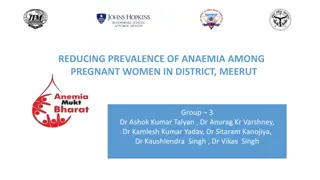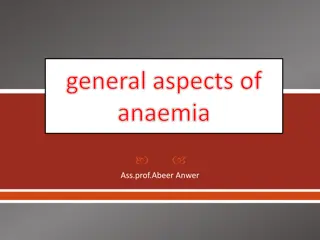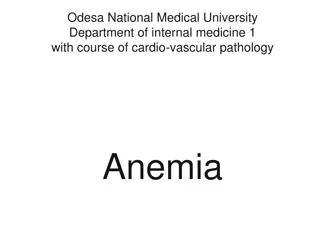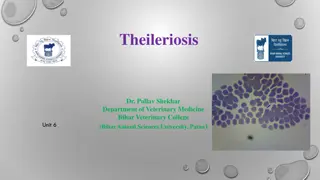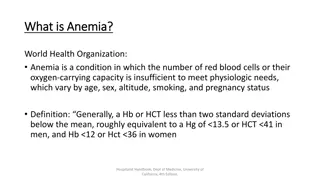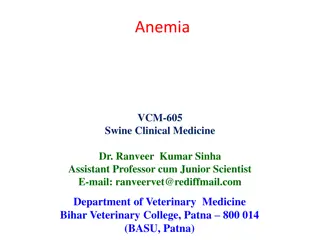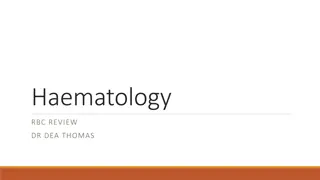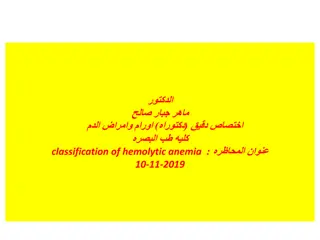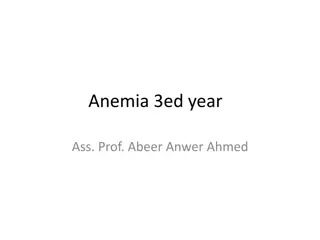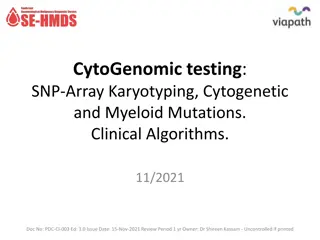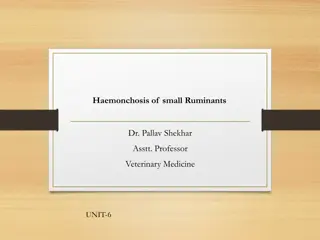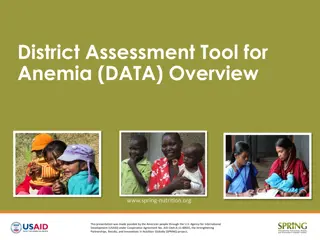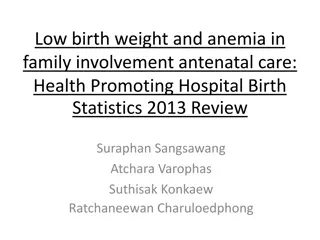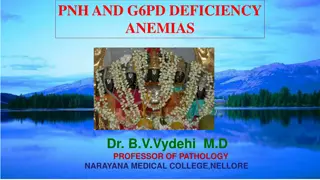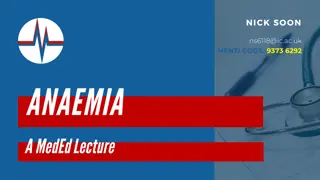Understanding Anemia: Key Concepts and Clinical Features
Anemia is a common condition characterized by a reduction in hemoglobin levels, leading to decreased oxygen-carrying capacity in the blood. This article delves into important aspects such as hematopoiesis, erythropoiesis, hemoglobin synthesis, and clinical manifestations of anemia. Learn about the symptoms, diagnostic indicators, and complications associated with various types of anemia for a comprehensive understanding of this blood disorder.
Download Presentation

Please find below an Image/Link to download the presentation.
The content on the website is provided AS IS for your information and personal use only. It may not be sold, licensed, or shared on other websites without obtaining consent from the author. Download presentation by click this link. If you encounter any issues during the download, it is possible that the publisher has removed the file from their server.
E N D
Presentation Transcript
anemia Color coding : ) ( , important Extra info DON T FORGET to check our editing file : haematology edit Notes from lecturer Please don Please don t hesitate to t hesitate to contact us on: contact us on:Haematology Haematology434 434@gmail.com @gmail.com
HEMATOPOIESIS O2 O2 Identical cells O2 O2 A) Hematopoiesis stem cells (HSC) characteristics: 1- self renewal 2- cell differentiation Prophyrin ring Globin chain B) Transcriptional factor: It s effects permit HSC proliferation and nuclear regulation. Hemoglobin: Hemoglobin: is the protein molecule in RBC that carries O O2 2 from the lungs to the body's tissues and returns CO returns CO2 2 from the tissues back to the lungs. Hemoglobin maintains the shape maintains the shape of RBC. carries Erythropoietin Erythropoietin : hormone secreted by kidney binds onto membrane receptors of cells that will become Erythrocyte (RBCs).
Erythropoiesis process of RBCs formation Late Normoblast Intermediate Normoblast Reticulocyte Erythrocyte Basophilic Normoblast Erythroblast Folic acid Iron Ferrous Vit B12 Erythropoietin -Amino acids minerals - other regulatory factors Hb synthesis begin with erythroblast and stop with reticulocyte, it is highly active at normoblast especially intermediate normoblast. Erythroblast: the immediate precursor of a normal erythrocyte, reticulocyte & erythrocyte could be found in the circulation. The Bone Marrow is the major site with the need of:
This table is very important Normal range HCT Indices Male Female Hemoglobin(g/dL) 13.5-17.5 11.5-15.5 Hematocrit(PCV) % 40-52 36-48 Red cell count ( 10 ) 4.5-6.5 3.9-5.6 Mean cell volume (MCV)(fL) 80-95 Mean cell 30-35 hemoglobin(MCH)(pg) MCH MCV Hb Microcytic Hypochromic Normocytic Macrocytic Normochromic
anemia Clinical features Reduction of Hb concentration below the normal range for the age and gender Leading to decreased O2 carrying capacity of blood and thus O2 availability to tissues (hypoxia) general Positive Related to anemia : Weakness, headache, pallor lethargy and dizziness Related to compensatory mechanism: palpitation(tachycardia), angina cardiac failure Clinical features: presence of absence of clinical features depends on : speed onset severity Age Rapidly progressive anemia causes more symptoms than slow onset anemia due to lack of compensatory mechanisms Practice a convincing appearance. Personal speech and interaction with the audience. Mild anemia has no symptoms usually, symptoms appear if Hb less than 9g/dL specific Negative Spoon nail Iron deficiency Leg ulcers Sickle cell anemia Jaundice Hemolytic anemia Bone deformities Thalassemia major
Classification of anemia Very important Reduction of DNA synthesis: megaloblastic anemia: - B12 deficiency - Folate deficiency Myelodysplastic syndrome(MDS) Macrocytic anemia Reduction of prophyrin: sidroblastic anemia Hypochromic microcytic anemia Normocytic normochromic anemia Blood loss: acute bleeding Hemolysis: Autoimmune Enzymopathy Membranopathy Sickle cell anemia Reduction of iron: iron deficiency anemia Reduction of globin chain: thalassemia Reduction of RBCs production: BM failure
Iron deficiency anemia Iron is among the Iron is among the abundant minerals on abundant minerals on Daily absorption 1 mg earth ( earth (6 6%). %). Iron deficiency is the most Iron deficiency is the most Macrophage (1g) common disorder( common disorder( 24 24%). %). Transferrin (4mg) Liver and muscle myoglobin (650mg) Storage forms: Ferritin Haemosiderin Bone marrow erythroblast (150mg) Limited absorption ability : Limited absorption ability : Only 5 5- -10 10% of taken iron will % of taken iron will 1 1- -Only be absorbed. be absorbed. Urine faeces Skin nail hair Circulating hemoglobin (2.5g) 2 2- - Inorganic iron can not be Inorganic iron can not be absorbed easily. absorbed easily. It could be due Excess loss It could be due Excess loss Daily loss 1 mg menstrual loss (hemorrhage) due to hemorrhage due to hemorrhage
Iron absorption and regulation Explanation: In the duodenum(the site of absorption) dietry iron(fe3+) is converted to(fe2+) before absorption, and it enter throw DMT-1. Dietry heam absorption controlled by HCP-1 Hepcidin produced in liver and it s the major hormonal regulator of iron, it interfere with ferroportin either in intestine or macrophages so it inhibit iron absorption and release. Ferroportin is the only protein which is responsible for iron exit.
Iron absorption Iron absorption Causes of IDA Causes of IDA Factors favoring absorption Factor reducing absorption Haem iron Inorganic iron Ferrous Iron (Fe++) Ferric iron Fe+++ Acid vitamin C Alkalines Chronic blood loss Poor diet Iron def Iron overload Increased demands Malabsorption Pregnancy Tea Hemochromatosis Increased hepcidin Solubilizing agent (Sugar) Precipitating agent(phenol)
Iron absorption Body status Low iron stores high Increased demands absorption Balance between dietary enhancers & Inhibitory factors Iron Low Full iron stores absorption overload More absorption Enhancers: Inhibitors: More Iron Content and form of dietary iron Meat (haem iron) Fruit (Vitamin C) Sugar (Solubilizing agent ) Acids Dairy foods (calcium) High fiber foods (phytate) Coffee &tea (polyphenoles) Anti -Acids Heam Iron Ferrous Iron
Development of IDA 1 2 3 4 normal pre-latent Latent IDA Stores Normal Low Low Low MCV/MCH Normal Normal Low Low Hemoglobin Normal Normal Normal low May not appear normal Signs and symptoms Beside symptoms and signs of anaemia +/- bleeding patients present with: (A): Koilonychia (spoon-shaped nails) (B): Angular stomatitis and/or glossitis (C): Dysphagia due to pharyngeal web (Plummer-Vinson syndrome) very sever cases a only found in b c
Investigation Iron studies A total iron-binding capacity (TIBC or transferrin) test is used to measure the amount of iron in the body. IDA=LOW IRON+HIGH TIBC Very important to note the difference between thalassemia and IDA Cause both of them are microcytic microcytic hypochromic anemia hypochromic anemia IDA normal Microcytic hypochromic anemia with: Anisocytosis Anisocytosis( variation in size) MCV Change in CBC MCV Change in CBC Pokiliocytosis Pokiliocytosis (variation in shape) due to the differences in age of cells sense a RBC life span is 120 days making cells before anemia different than those after anemia.
Investigation prevention Meat is better source than vegetables. Dietary modification Food fortification (with ferrous sulphate) GIT disturbances ,staining of teeth & metallic taste. BM stands for bone marrow it s biopsy procedure For high risk groups. Iron supplementation: treatment Treat the underlying cause (don t play with the physiology of your body) Iron replacement therapy: Oral :( Ferrous Sulphate OD for 6 months) Intravenous:( Ferric sucrose OD for 6 months) (Hb should rise 2g/dL every 3 weeks)
Anemia of chronic disease Normochromic normocytic (usually) anemia caused by decreased release of iron from iron stores due to raised serum Hepcidin . Associated with - Chronic infection including HIV, malaria - Chronic inflammations -Tissue necrosis -Malignancy
1) hemoglobin responsiple for: a- carries O2 from body tissue to lung b- carries CO2 from lung to body tissue c- maintain the shape of RBCs d- all of the above 4) which on is true regarding anemia: a- mild anemia asymptomatic usually b- symptoms diappear even if Hb less than 9g/dL c- slow onset causes more symptoms than rapid progression d- young patient tolerate anemia less than elderly 1- C 2- B 3- D 4- A 2) which one of these is responsible for producing an identical cells: a- cell differentiation b- self renewal c- erythropoiesis d- IDA 5- C 5) the specific clinical feature of anemia is: a- lethargy b- palpitation c- spoon nail d- angina 3) which one of these is the major factory of synthesizing hemoglobin: a- basophilic normoblast b- late normoblast c- reticulocyte d- intermediate normoblast
Q) what is the anemia that caused by reduction of prophyrin? A) sidroblastic anemia Q) why is the iron defeciency the most common disorder? a-only 5-10% of taken iron will be absorbed. b- inorganic iron can not be absorbed easily. It could be due Excess loss due to hemorrhage. Q) what are the iron studies that we find in IDA? 1- haigh total iron binding capacity 2- low serum iron 3- low serum ferritin 4- low transferrin saturation
Thank you for checking our work Now you can check a lecture out :D Done by: Mohammed albadrani Khalil alhindas Saleh albnyan Abdulrahman alnoeam Reviewedby : Hadeel B. Alsulami Abdullah M. Albasha , : , ( )



